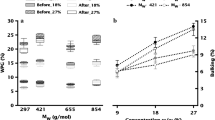Abstract
Due to European environmental regulations, solvent-borne wood coating systems have to be replaced by water-borne and high solid coatings. Thorough research is yet needed to replace the traditional solvent-borne systems by water-borne paints and stains for exterior wooden joinery. In this article the penetration of paint primers and wood stain base-coats (solvent-borne and water-borne as well as high solids and hybrid systems) in wood is discussed. Penetration is an important factor for the durability of a coating and thus the protection of the wood. For the image capturing a confocal scanning lasermicroscope (CSLM) was used. Penetration was measured using two methods. Further statistical analysis was done to determine the factor that influenced the penetration the most.
Zusammenfassung
Gemäß europäischer Umweltverordnungen müssen Farben auf Lösemittelbasis durch Anstriche mit Wasser als Lösemittel und hochfestem Anstrich ersetzt werden. Gründliche Forschung ist jedoch notwendig, um die traditionellen Systeme auf Lösemittelbasis zu ersetzen durch wasserlösliche Anstriche und solche für Außenverwendung. In diesem Beitrag wird die Eindringtiefe der Grundierungen und Anstrichsysteme in Holz diskutiert (Anstriche auf Lösemittelbasis, wasserlösliche Systeme sowie hochfeste und Hybridsysteme). Eindringtiefe ist ein wichtiger Faktor für die Dauerhaftigkeit einer Farbschicht und somit für den Schutz des Holzes. Für die Bilderzeugung wurde ein konfokales Lasermikroskop verwendet. Die Eindringtiefe wurde unter Anwendung zweier Methoden gemessen. Weitere statistische Analysen wurden durchgeführt, um den Faktor zu bestimmen, der die Eindringtiefe am stärksten beeinflusste.












Similar content being viewed by others

References
Ahola P (1991) Moisture transport in wood coated with joinery paints. Holz Roh- Werkstoff 49:428–432
Arnold M, Lemaster RL, Dost WA (1992) Surface characterization of weathered wood using a laser scanning system. Wood Fibre Sci 24:287–293
Côté WA, Robinson RG (1968) A comparative study of wood: wood coating interaction using incident fluorescence and transmitted fluorescence microscopy. J. Paint Technol. 40:427–432
De Meijer M (1999) Interactions between wood and coatings with low organic solvent content. PhD thesis, Wageningen Agricultural University, 177 pp.
Donaldson LA, Lausberg MJF (1998) Comparison of conventional transmitted light and confocal microscopy for measuring wood cell dimensions by image analysis. IAWA Journal 19:321–336
Matsumura J, Booker RE, Donaldson LA, Ridoutt BG (1998) Impregnation of radiata pine wood by vacuum treatment: identification of flow paths using fluorescent dye and confocal microscopy. IAWA Journal 19:25–33
Nussbaum RM, Sutcliffe EJ, Hellgren AC (1998) Microautoradiographic Studies of the Penetration of Alkyd, Alkyd Emulsion and Linseed Oil Coatings Into Wood. J Coatings Technol 70:49–57
Rijckaert V, Van Acker J, Stevens M, De Meijer M, Militz H (2001) Quantitative analysis of the penetration of water-borne primers into wood by means of fluorescence microscopy. Holz Roh- Werkstoff 59:278–287
Rødsrud G, Sutcliffe EJ (1994) Alkyd emulsion properties and application. Results from comparative investigations of penetration and ageing of alkyds, alkyd emulsions and acrylic dispersions. Surface Coatings International, 1:7-16
Shotton DM (1989) Confocal scanning optical microscopy and its applications for biological specimens. J Cell Sci 94:175–206
Sum ST, Singleton DL, Paraskevopoulos G, Irwin RS, Barbour RJ, Sutcliff R (1991) Laser-excited fluorescence spectra of eastern SPF wood species. An optical technique for identification and separation of wood species? Wood Sci Technol 25:405–413
Swaraj P (1982) Physico-chemical interpretation of paint film adhesion. J Coatings Technol 54:59–65
Thay PD, Evans PD (1997) The adhesion of an acrylic primer to weathered radiata pine surfaces. Wood Fiber Sci 30:198–204
Van Loon J (1966) The interaction between paint and substrate. Journal of the Oil & Colour Chemists' Association 49:844–867
Williams SR, Winandy JE, Feist WC (1987) Adhesion of paint to weathered wood. Forests Prod J, 40:45–49
Acknowledgements
The authors appreciate the support given by Akzo Nobel Decorative Coatings (Vilvoorde, Belgium) for the preparation of the test products and Prof. P. Van Oostveldt (Laboratory of Molecular Biotechnology, Ghent University) for the kind permission to use the confocal lasermicroscope.
Author information
Authors and Affiliations
Corresponding author
Rights and permissions
About this article
Cite this article
Van den Bulcke, J., Rijckaert, V., Van Acker, J. et al. Quantitative measurement of the penetration of water-borne coatings in wood with confocal lasermicroscopy and image analysis. Holz Roh Werkst 61, 304–310 (2003). https://doi.org/10.1007/s00107-003-0394-5
Published:
Issue Date:
DOI: https://doi.org/10.1007/s00107-003-0394-5



